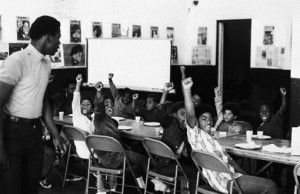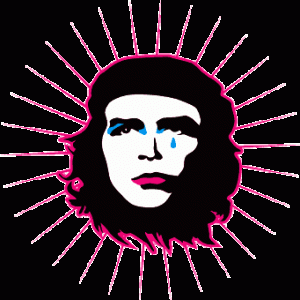Political organisation in post-crisis UK
A version of this article will appear in the forthcoming issue of arranca, no. 47
 The year is 1973. David Bowie, in the guise of his persona Ziggy Stardust, is on stage at London’s Hammersmith Odeon. It is the end of a hugely successful sixty-gig tour. The figure of Ziggy Stardust has deeply affected many – the cultural movement of Glam he has sparked is an important moment in loosening gender roles. Yet just before the final song of the night, ‘Rock’n’Roll Suicide’, Ziggy announces: “Not only is this the last show of the tour, but it’s the last show that we’ll ever do.” This is not just a shock for the audience, it’s also news to his backing band, The Spiders From Mars. Why would anyone stop at the height of their success? But Bowie has decided it’s time for a new character and a new direction. In this article we want to pose the following questions in terms of political organisation: When do you know it’s time to stop doing what you’re doing and try something else? How do you know what to take with you and what to leave behind? And how can you truly ask ‘What is to be done?’ without past experience overcoding your answer?
The year is 1973. David Bowie, in the guise of his persona Ziggy Stardust, is on stage at London’s Hammersmith Odeon. It is the end of a hugely successful sixty-gig tour. The figure of Ziggy Stardust has deeply affected many – the cultural movement of Glam he has sparked is an important moment in loosening gender roles. Yet just before the final song of the night, ‘Rock’n’Roll Suicide’, Ziggy announces: “Not only is this the last show of the tour, but it’s the last show that we’ll ever do.” This is not just a shock for the audience, it’s also news to his backing band, The Spiders From Mars. Why would anyone stop at the height of their success? But Bowie has decided it’s time for a new character and a new direction. In this article we want to pose the following questions in terms of political organisation: When do you know it’s time to stop doing what you’re doing and try something else? How do you know what to take with you and what to leave behind? And how can you truly ask ‘What is to be done?’ without past experience overcoding your answer?
These are pertinent questions. The deep and prolonged crisis of neoliberal capitalism has created a situation that pre-2008 ‘politics as usual’ seems unable to address. This has created a crisis of political organisation right across the globe. In the UK two distinct traditions of the Left are undergoing organisational crises of some scale. Yet they are also beginning to interact in ways that suggest a political recomposition might be possible.
The first of these crises has become visible through a series of splits and scandals in the organised (mainly Trotskyist) Left. The most prominent of these has been the crisis shaking the Socialist Workers Party (the SWP; the British section of the International Socialist Tendency), initially triggered by allegations of rape against one of its leading members (“Comrade Delta”). On one level, it has highlighted the depths of chauvinism which still exist among so-called revolutionaries, prompting a series of different allegations of sexual abuse, assault and harassment. Moreover, the heavy-handed response by the SWP leadership has further exposed the bureaucratic centralism that lies at the heart of the way Trotskyists have organised in the UK, throwing into crisis the strategy that has dominated the Left for the last thirty years. With neoliberalism in the ascendant, most left groups have undertaken activity with the primary aim of holding together and if possible growing their own organisation. This approach, talked of in term of a ‘downturn’, is justified by the idea of holding out until ‘objective conditions’ change (at which point the organisation will swiftly become a mass party capable of effecting or influencing change). The problem now, of course, is that ‘objective conditions’ have changed: a global economic meltdown, a massive transfer of funds to the rich in the form of bank bailouts, a regime of deepening austerity… But no part of the organised Left is growing or gaining more traction on the world
Not surprisingly many comrades have been left disoriented, and some have started to re-examine their whole way of doing politics. As one SWP dissident puts it, this “horrible scandal is also the occasion of a form of radicalisation on the left, particularly the revolutionary left, in which many people are literally re-evaluating their root assumptions.”[1] There are a number of regroupments currently underway, and some seem genuine in their desire to move away from a culture of bureaucratic manoeuvres, opportunism and group patriotism. However, this re-evaluation of core assumptions needs to recognise that the roots of the crisis go much further than the actions of “Comrade Delta”. In many respects they correspond to a historical crisis of the monolithic and monopolistic Party-form. For large periods of the twentieth century, that form of organisation made sense (to many, at least). The Party was a way to organise. It was a way to understand. And it was a way to act. But neoliberalism has bulldozed the terrain on which the Party operated. Changes in class composition – the way we work, live, learn and so on – have rendered this Leninist mode of organisation obsolete. As a product of a particular Fordist conception of time and space, the Party was always flawed, but it makes very little sense in the twenty-first century.[2]
This brings us to the second Left tradition currently in crisis, which we can loosely characterise as network-based or horizontal. During the years of 2010–11 this form of politics seemed to offer real traction as people struggled to get to grips with the fiscal meltdown. From Athens to Cairo to Madrid to Oakland, square occupations and mass assemblies took hold across the globe. Consensus decision-making, once a marginal technique for seasoned activists, was adopted and adapted by hundreds of thousands of people. Occupy, 15-M, the indignados, the Arab Spring – for a time they all held the promise of radical social change. But they have since faded or stalled. Two related weaknesses seem particularly relevant: first, the open assembly form which characterised these movements seems to have an inbuilt tendency towards inertia; second, while the initial occupations of 2010–11 built collectivity by bringing people into a space, they were less successful in developing a consistency which could allow that new body to stick together and move on.
No doubt both traditions have organisational lessons for each other and some discussion has led in this direction. But perhaps this approach is the wrong way round. Organisational forms are undoubtedly important but we need to first consider what the actual role of political organisations could and should be today. What we want to do here is look at the various functions that have been fulfilled, at different times and places, by political parties (understood in the loosest sense as semi-permanent political organisations). Which of these functions are still necessary? And are there ways we can address them without the drawbacks of the hierarchical Party-form?
The most obvious function of any political organisation is simply to hold together a network of militants. It both establishes a pole of attraction and offers an easy entry point into a movement (something that loose networks can’t always do). But as we have seen in the case of the SWP, the activities and mentalities best suited to keeping a group together risk cutting members off from new waves of struggle that erupt in an unexpected place or form. In effect, organisations pay a price for prioritising their own reproduction during a downturn: when new movements emerge, the organisation may be so warped that it’s unable to play a useful role. The picture is complicated further because another classic function of the party is to act as the memory of the class, carrying forward the lessons of previous waves of struggle. These functions are vital if we are to build our capacity but how do we avoid mistaking each new movement for a repetition of our own formative experiences? Useful memory requires some forgetting.[3]
Political parties have a poor track record in part because of their failings in a third function: political organisations must be a vehicle for collective analysis. It is only by understanding how institutional dynamics can cramp our thought and actions that organisations can overcome them and adapt to the changing composition of society. Of course if this is to be more than mere navel-gazing then the analysis must also look outwards, not just at how capitalism is changing but also at how our thought is conditioned and limited by the shape of present society. The task is not only to interpret the world, but to generalise the practice of collective analysis throughout society (and therefore to change it).
 But if creating the right conditions for collective analysis within an organisation seems difficult, then creating those conditions throughout society seems unapproachably vast. How can we work towards this goal? One way forward positions political organisation in an infrastructural role. Rather than just pressuring institutions such as governments to institute change, organisations can directly produce infrastructure that works towards collective self-mastery. On the micropolitical level this can involve producing concepts, narratives, tactics, tools and technologies that can then be picked up and adapted by others for use in their own situation. But we also need to act on a corporeal level. We’re not used to thinking of political organisations playing a role in the infrastructure of social reproduction, but this may prove crucial in the coming years as state provision is further slashed. There is a history of parties directly providing welfare and care for their members and for a wider public, and there may be much to learn from the experiences of the Black Panther Party in the United States, the MST in Brazil and even the German SDP in the early 20th century. Yet where to begin amidst the present generalised crisis of social reproduction? We have no easy answer but linking such efforts to the infrastructure of collective analysis may help us narrow the field.
But if creating the right conditions for collective analysis within an organisation seems difficult, then creating those conditions throughout society seems unapproachably vast. How can we work towards this goal? One way forward positions political organisation in an infrastructural role. Rather than just pressuring institutions such as governments to institute change, organisations can directly produce infrastructure that works towards collective self-mastery. On the micropolitical level this can involve producing concepts, narratives, tactics, tools and technologies that can then be picked up and adapted by others for use in their own situation. But we also need to act on a corporeal level. We’re not used to thinking of political organisations playing a role in the infrastructure of social reproduction, but this may prove crucial in the coming years as state provision is further slashed. There is a history of parties directly providing welfare and care for their members and for a wider public, and there may be much to learn from the experiences of the Black Panther Party in the United States, the MST in Brazil and even the German SDP in the early 20th century. Yet where to begin amidst the present generalised crisis of social reproduction? We have no easy answer but linking such efforts to the infrastructure of collective analysis may help us narrow the field.
The above functions are ones which could address some of the weaknesses apparent in horizontal politics. But political parties have also had other aims which are perhaps more problematic. The first is leadership. This is traditionally a tricky question for libertarians, but the events of 2010–11 can be used to shed new light on this problem. In those uprisings we saw the effectiveness of a very viral form of politics, where ideas and practices developed in one location became contagious and spread across thousands of miles in a matter of days. So we can think of groups providing leadership by example: if initiatives make sense and are easily replicable, they are picked up by others who have no formal connection to the original group.[4] However, unlike the traditional idea of leadership, there is no guarantee that the same group will provide the right idea next time. So leadership can also be a matter of acting as an amplification chamber: in 2010–11 pre-existing groups or networks played the role of early adopters, picking up new forms of action and helping them to spread.
Even more awkward is the question of state power, which lies at the heart of the Bolshevik form of organisation. Can we change the world without taking power? It’s an open question, but when movements make gains, we sometimes need them embodied in institutional change (such as changes in the law). This means that at some stage we will have to address the relation between movements and electoral parties.[5]
None of the functions listed so far – maintenance of collectivity; class memory; analysis; welfare; leadership; seizure of power – are in themselves revolutionary. All of them can be carried out in a way that reproduces existing social relations, reinforcing passivity, cynicism, hierarchy, alienation, or our reliance on others to do things on our behalf.[6] An organisation fulfilling these functions could still prioritise its own reproduction (as with the organised Left) or drift towards entropy (as with horizontalism). In order to move beyond this, we can think of political organisation as operating simultaneously on three different levels. The first is the level of membership, as a body of militants committed to each other and operating within discrete boundaries. The second level is more diffuse, encompassing a wider network of supporters, friends and sympathisers. The six functions listed so far operate almost exclusively on these two levels. But there is a third level, that of perspective, which refers to the process whereby people come to identify with the politics of a movement. This final party function, which we think could be the most useful today, is also the most difficult to get a grip on. It takes place on the terrain of desire, so we want to use a psychoanalytic term, transference, to help us think it through.
Let’s return to the square occupations of 2010–11. Why was the general assembly such a prominent part of the Occupy moment? On the surface it was about consensus decision-making but the real driver was the space it offered for people to come forward, express themselves politically and be taken seriously. It was a powerful experience: by testifying in a collective situation people were able to recognise their commonality with others and recognise themselves as active subjects. The problem, however, is that testifying is not enough. It runs the risk of getting trapped inside an identity, a sterile celebration of “the 99 per cent” rather than an attempt to abolish all such categories.[7] Changing the world means changing ourselves, it means becoming different people. So as well as projecting and recognising ourselves as we are, how can we recognise each other as we change? This is where we think the concept of transference can be useful.
In psychoanalysis the concept of transference is used to capture the way the relationship between the analyst and the analysand (the ‘patient’) becomes caught up in the process of transformation. When a person is analysed, they tend to redirect their feelings towards the analyst: transference can be manifested as erotic attraction but can also take the form of rage, hatred, mistrust etc. Freud saw this as a patient deflecting their feelings about their father, for example, on to the analyst. The analyst is supposed to guide the transformational process by pointing out this transference, allowing the analysand to recognise the subjectivities at work, and start to resolve their problems. In this way, the analyst becomes a screen on which original traumas can be played out, recognised and then resolved. The analysand can also recognise their transformation in their altered attitude towards the analyst.
We’re not arguing for a psychoanalytic politics here. But this notion of transference seems to offer insight into how we relate to both political organisations and to political leaders. Under some conditions this projection onto a leadership figure might provide confidence in political change: the figure of Hugo Chavez, for example, allowed the poor to recognise themselves as an active subject in Venezuela in a way that seemed improbable. Of course, it’s fraught with difficulties. During the process of psychoanalysis, the therapist can appear all-knowing or god-like.[8] By using a leader as a screen, it can appear that the potential for change is the unique property of one special body (the party or the leader). When Chavez died in March 2013, did the potential for political transformation die with him, or did it remain in the social body as a whole?
 We can also see transference at work in a more oblique way. Korda’s heroic photo of Che Guevara turned the Argentine revolutionary into a classic political icon on walls, t-shirts and banners across the world. The bearded, long-haired Che in a black beret stood for the desire for revolution. Fast forward thirty years and a different figure emerges from the jungle: Subcomandante Marcos is masked, literally faceless. His ‘real’ identity is irrelevant: with his balaclava and pipe he is a blank screen on which to project a desire for radical social change. And this difference in the two icons is reflected in their different attitudes towards being a revolutionary. Che demands that we follow him into the jungle and through armed struggle create the new man. For Marcos, being a revolutionary means struggling where we live. Rather than travelling to Chiapas, we can be Zapatistas in the streets of Leeds.
We can also see transference at work in a more oblique way. Korda’s heroic photo of Che Guevara turned the Argentine revolutionary into a classic political icon on walls, t-shirts and banners across the world. The bearded, long-haired Che in a black beret stood for the desire for revolution. Fast forward thirty years and a different figure emerges from the jungle: Subcomandante Marcos is masked, literally faceless. His ‘real’ identity is irrelevant: with his balaclava and pipe he is a blank screen on which to project a desire for radical social change. And this difference in the two icons is reflected in their different attitudes towards being a revolutionary. Che demands that we follow him into the jungle and through armed struggle create the new man. For Marcos, being a revolutionary means struggling where we live. Rather than travelling to Chiapas, we can be Zapatistas in the streets of Leeds.
The figure of Marcos may be more suited to today’s struggles than Che, but is there a way that we can address this function of leadership through a relation of transference in an even more horizontal way? Perhaps we can step away from the field of politics and think of other examples where we invest desire. As ever, we can turn to pop music to find inspiration. When the Sex Pistols first appeared on TV, they sent shockwaves throughout popular culture. There was an element of leadership but the DIY ethos of punk was also about near-maximum horizontality. Unlike Chavez, people didn’t want to follow Johnny Rotten – they wanted to be Johnny Rotten. Of course, the trajectory of Rotten is also a grim warning of what can go wrong. He may have reverted to the name to John Lydon, but he is forever trapped in a persona he adopted as a 17-year-old, one that he can’t escape.
We return to the vignette with which we started. It was precisely the explicit otherworldly inauthenticity of Ziggy Stardust – a supposed emissary through which alien visitors were speaking – that made him such an effective transferential figure. Whereas Rotten’s persona could be mistaken for the actual person of John Lydon, this was less the case with Ziggy.[9] Yet many wanted to adopt the persona because it showed them a way forward: they used it to change themselves and to recognise others who were doing the same. Moreover it was the suicide of the character, with Bowie killing it off and adopting a new one, which forced the audience to recognise the mechanism of transference. Unlike the final Sex Pistols gig, this transformation didn’t treat the fans as imbecilic subjects of a swindle. Instead it revealed Ziggy Stardust as a shared contrivance through which both star and audience were transforming themselves. Of course even this is not enough for us. The trick is to do away with the star while retaining the character.[10] Gaining control of the transferential figure should be the very object of collective analysis. Only when we have achieved this can we become the collective authors of the narratives of our own lives.
[2] If the traditional Party has sought a monopoly on politics and adopted an annex-or-destroy attitude to its competitors, then today we need to break with this and adopt a new protocol to enable groups and organisations to coordinate together without falling into attempts at false unity.
[3] We discuss this problem in more detail here: http://freelyassociating.org/regeneration/
[4] For further discussion of these dynamics see http://freelyassociating.org/on-fairy-dust-and-rupture/
[5] We have little to say here as it is not a live topic to us: there simply are no potential institutional partners for movements in the UK.
[6] Taken from the influential but now long-defunct UK libertarian socialist group Solidarity. See http://libcom.org/library/as-we-see-it-dont-see-it-solidarity-group
[7] For an online example of the assembly moment see wearethe99percent.tumblr.com
[8] Indeed it is the supposed knowledge of the analyst that can provide the analysand with the confidence to continue the disruptive process of self-transformation. Transposing this problem onto the political organisation returns us to the problem of historical memory and forgetting.
[9] Although allegedly a cocaine-addled Bowie had some problems maintaining the distinction.
[10] For actually existing experiments with just this sort of problem we can look at San Precario the patron saint of precarious workers and Hamburg’s precarious superheros.

Comments Off on Rock ’n’ Roll Suicide